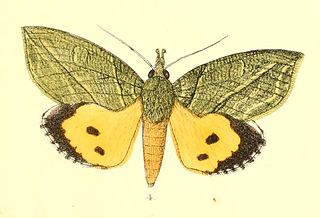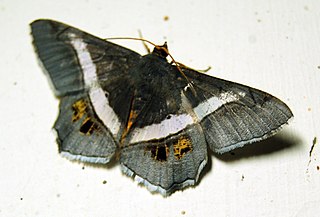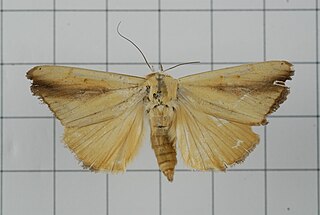
Arsacia is a monotypic moth genus of the family Noctuidae. Its only species is Arsacia rectalis. Both the genus and species were described by Francis Walker, the genus in 1866 and the species in 1863. It is found from the Indo-Australian tropics of India, Sri Lanka to Queensland and the Solomon Islands.

Plutodes is a genus of moths in the family Geometridae erected by Achille Guenée in 1857.

Eudocima hypermnestra is a moth of the family Erebidae described by Pieter Cramer in 1780. It is found in China, Thailand, Taiwan, India and Sri Lanka.

Chiasmia nora is a moth in the family Geometridae, described by Francis Walker in 1861. It is found in northern India, Sri Lanka, south-eastern Asia and probably throughout Sundaland.

Chiasmia emersaria is a moth of the family Geometridae. The species was first described by Francis Walker in 1861. It is found in India, Nepal, northern Thailand, China, Sri Lanka, Japan and the Ryukyu Islands.

Eucyclodes gavissima, the Oriental orange banded green geometer moth, is a species of moth of the family Geometridae described by Francis Walker in 1861. It is found in the Indian subregion, Sri Lanka, Bhutan, western China, Taiwan, Vietnam, Sumatra and Borneo.
Trichoplusia lectula is a moth of the family Noctuidae first described by Francis Walker in 1858. It is found throughout Asia, including the Indian subregion, Sri Lanka, Thailand, Borneo, Java, Japan, as well as Western Australia and Queensland.

Fascellina chromataria is a moth in the family Geometridae described by Francis Walker in 1860. It is found in Korea, Japan, Taiwan, China, India, Bhutan and Sri Lanka.

Europlema desistaria is a species of moth of the family Uraniidae first described by Francis Walker in 1861. It is found in India, Sri Lanka, Myanmar, Thailand, Taiwan, Borneo, Sulawesi, Flores and Queensland.

Gesonia obeditalis is a species of moth of the family Noctuidae first described by Francis Walker in 1859. It is found from eastern Africa, the Seychelles, the Maldives and the Oriental tropics of India, Myanmar, Sri Lanka east to the Philippines, the Sula Islands and Australia. The adult moth has brown wings with a scalloped dark brown band near the margin. The hindwings are similar in pattern to the forewings but are a paler shade of brown.
Scopula addictaria is a moth of the family Geometridae. It was described by Francis Walker in 1861. It is found in Sri Lanka.
Ziridava xylinaria, the indistinct carpet, is a moth in the family Geometridae. The species was first described by Francis Walker in 1863. It is found in Sri Lanka, India, Hong Kong and on Peninsular Malaysia, Borneo, Java and possibly the Philippines and Sulawesi.
Gymnoscelis imparatalis, the flower-looper moth, is a moth in the family Geometridae. It is found from the Indo-Australian tropics of India, Sri Lanka, east to the Society Islands and the Marquesas Archipelago. The habitat consists of both lowland and montane ecosystems.
Gymnoscelis deleta is a moth in the family Geometridae. It is found in India, Korea, Japan, Taiwan and probably in Sri Lanka according to Hampson.

Hypomecis separata is a species of moth of the family Geometridae. It was first described by Francis Walker in 1863. It is found in Sri Lanka, India, Java and Borneo.

Risoba repugnans is a species of moth of the family Nolidae first described by Francis Walker in 1865.
Trischalis absconditana is a moth in the family Erebidae. It was described by Francis Walker in 1863. It is found in Assam in India and in Sri Lanka.

Egnasia ephyrodalis is a moth of the family Noctuidae first described by Francis Walker in 1858.

Xanthodes transversa, the transverse moth or hibiscus caterpillar, is a moth of the family Nolidae. The species was first described by Achille Guenée in 1852. It is found in India, Sri Lanka, the Andaman Islands, the Nicobar Islands, China, Hong Kong, Vanuatu, Java, New Guinea, Japan, the Ryukyu Islands, Singapore, Indonesia and Australia.

Xanthodes intersepta is a moth of the family Nolidae first described by Achille Guenée in 1852. It is found in India, Sri Lanka, Myanmar, China, Hong Kong, Japan, the Ryukyu Islands, the Philippines, Indonesia and Java.













